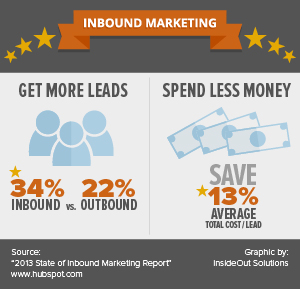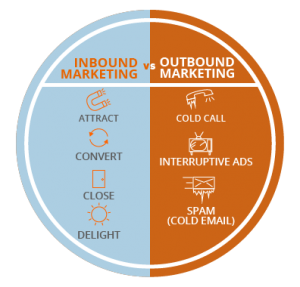Inbound marketing is a buzzword, but it’s not a new concept. Industry analysis proves that it leads to a greater return on investment (ROI) for all business sizes. This has given the various aspects of inbound marketing increasing traction in the past few years.
Trusted sites like HubSpot and Moz publish vast amounts of education and trends analysis. Each demonstrate that inbound marketing is a profitable approach to gaining and keeping customers.
What is inbound marketing? How is it different from outbound marketing?
Inbound marketing is earning the trust of today’s consumers to attract them to your website and convert them into leads. The goal is to convert the leads into customers by following the inbound marketing process.
Inbound marketing’s methodology according to HubSpot comprises 4 sequential phases: 1) attract; 2) convert; 3) close; and 4) delight. The very idea of this process revolves around how to engage the consumer and earn trust. Compare that with outbound marketing, which seeks to interrupt the consumer to sell a product. Often, only the product or service is the focus of outbound marketing. In outbound marketing’s philosophy, the consumer isn’t meant to engage in a meaningful, transactional relationship with the brand except to continue buying it because of numerous interruptive ads or calls.
For example, do you remember sitting down at the dinner table years ago? All the food was piping hot. The family, tired from a long day, was ready to eat. Inevitably, the phone rang. If you were lucky, it was a family member or friend that you could delay. If you weren’t lucky, it was a salesman, who barely allowed you to say “hello” before bombarding you with a scripted pitch and preventing you from getting a word in edgewise to tell him “no thank you.” If you weren’t bold enough to hang up, you probably had to endure about ten to fifteen minutes of escalating sales pitches as you declined from one to another. When at last the salesman admitted defeat, you could return to your cold dinner. This scenario defines the gist of outbound marketing.
Fast forward to today. Inbound marketers aren’t cold calling you as dinner begins to interrupt your meal or your life. Instead, they’re inviting you, when you’re ready, to come to them. Inbound marketing enables a company to make itself known and available. So if you’re looking for a great B&B to visit, you enter some search criteria in Google and away you go. You read blogs. You navigate the site and review various rooms. You study the menu and the wine selection. Sometimes you sign up on email lists to get information about the B&B, or local events and attractions. You narrow down the choices of where you want to stay and consider the experience you want. Finally, you decide where to spend the weekend. Then, inbound marketing influences that B&B to delight you as a guest and continue delighting you after you’ve left the destination by engaging you in social media, informing you about future specials, all in a non-interruptive way.
Ultimately, inbound marketing’s primary focus is on engaging and delighting an inquisitive consumer.
So, why should you invest in inbound marketing?
According to HubSpot’s “2013 State of Inbound Marketing Report,” 54% more leads are generated by inbound marketing versus outbound marketing. More leads means a greater potential of converting them into customers.
Can I really afford to invest in something new?
 If you currently invest in outbound marketing, you know it’s expensive. However, data shows inbound marketing saves money in generating leads. According to HubSpot’s report, marketers that spent more than $25,000 per year “saved an average of 13% in overall cost per lead . . . versus those relying on outbound strategies.”
If you currently invest in outbound marketing, you know it’s expensive. However, data shows inbound marketing saves money in generating leads. According to HubSpot’s report, marketers that spent more than $25,000 per year “saved an average of 13% in overall cost per lead . . . versus those relying on outbound strategies.”
Realistically, not all business owners are able to spend over $25,000 per year on marketing. However, the widely accepted recommendation for B&B inn owners is to spend at least 10% of your gross revenue on it. As a business owner, one goal is to maximize your ROI. If you’re going to spend the 10%, inbound marketing is currently the preferred method for greater ROI. For you, that means rooms that are consistently occupied, and potentially the reduction or even complete disappearance of the “slow season.”
Join us for our next post which will highlight the tools of inbound marketing, and how they might be used in the hospitality industry.

